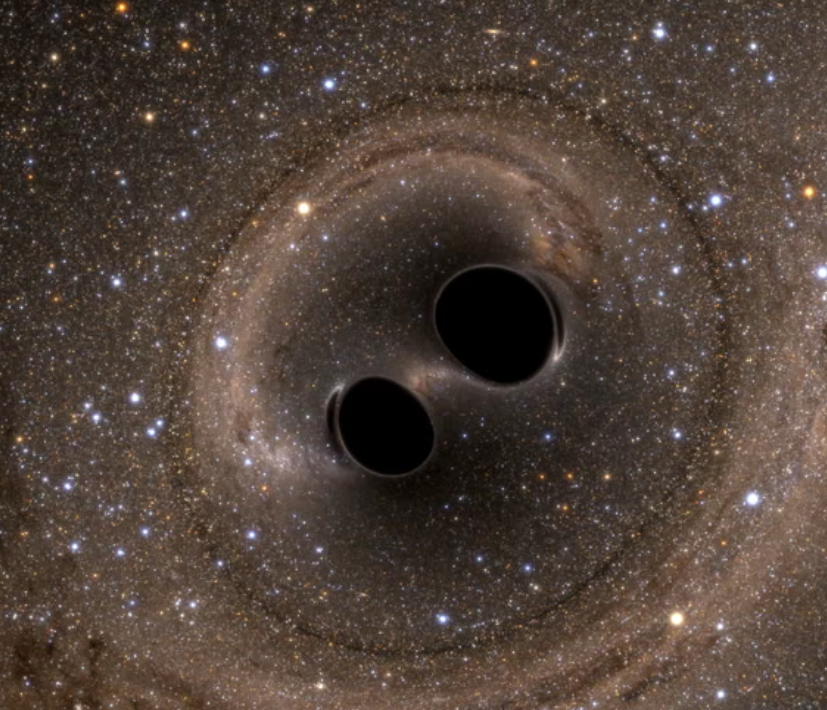Science
Gravitational Wave Discoveries Transform Understanding of Black Holes

October and November 2024 marked a significant period for gravitational wave astronomy, as the LIGO-Virgo-KAGRA collaboration detected two black hole mergers that challenge existing theories about their formation and evolution. Both events revealed black holes with unusual spinning characteristics, suggesting a more complex history than previously understood.
The first merger, designated GW241011, occurred approximately 700 million light years away. This event involved two black holes, one with a mass of 20 solar masses and the other with 6 solar masses, spiraling together. Notably, the larger black hole exhibited one of the fastest spins ever recorded through gravitational waves, indicating a violent history rather than a typical stellar origin.
A month later, astronomers detected GW241110 at a staggering distance of 2.4 billion light years. This merger involved black holes with masses of 17 solar masses and 8 solar masses. The primary black hole in this merger displayed a spin oriented in the opposite direction to its orbit—a configuration that has never been directly observed before.
Implications for Black Hole Formation
These remarkable spin properties have profound implications for our understanding of black hole origins. Typically, when massive stars collapse, they form black holes with modest spins that align with their original orbital motion. The extreme spins observed in both GW241011 and GW241110 suggest they are not first-generation black holes formed directly from stellar collapse. Instead, they appear to be second-generation black holes, likely produced by earlier mergers. This lineage indicates that they may have undergone multiple collisions, resulting in their rapid spins and unexpected orientations.
In both mergers, the larger black hole was nearly double the mass of its companion, a mass disparity that aligns more closely with hierarchical mergers rather than binary star systems that form together. This pattern hints at the assembly of these black holes in dense stellar environments, such as globular clusters, where they can frequently interact and merge over time. Each collision not only adds mass but also alters spin characteristics, leading to the unique properties observed in these recent events.
Confirming Einstein’s Theories
The clarity of the gravitational wave signal from GW241011 allowed astronomers to verify Albert Einstein’s general relativity with remarkable precision. The rapid rotation of the primary black hole caused it to deform slightly, an effect predicted by the mathematical solutions of Roy Kerr for rotating black holes. This deformation generates a unique signature in the gravitational waves that aligns closely with theoretical predictions.
Additionally, the signal from GW241011 included higher harmonics, akin to musical overtones, confirming another prediction from Einstein’s theory regarding the behavior of gravitational waves. As detection sensitivity improves, researchers anticipate uncovering more phenomena like GW241011 and GW241110, which will further illuminate the diverse environments in which black holes collide.
The discoveries made during these months not only enhance our understanding of black holes but also refine the fundamental laws governing these extraordinary cosmic entities. As the field of gravitational wave astronomy continues to evolve, it promises to unveil even more about the universe’s most enigmatic objects.
-

 Science3 weeks ago
Science3 weeks agoInterstellar Object 3I/ATLAS Emits Unique Metal Alloy, Says Scientist
-

 Science4 weeks ago
Science4 weeks agoResearchers Achieve Fastest Genome Sequencing in Under Four Hours
-

 Politics4 weeks ago
Politics4 weeks agoAfghan Refugee Detained by ICE After Asylum Hearing in New York
-

 Business4 weeks ago
Business4 weeks agoIconic Sand Dollar Social Club Listed for $3 Million in Folly Beach
-

 Health4 weeks ago
Health4 weeks agoPeptilogics Secures $78 Million to Combat Prosthetic Joint Infections
-

 Lifestyle4 weeks ago
Lifestyle4 weeks agoJump for Good: San Clemente Pier Fundraiser Allows Legal Leaps
-

 Business4 weeks ago
Business4 weeks agoMcEwen Inc. Secures Tartan Lake Gold Mine Through Acquisition
-

 Science4 weeks ago
Science4 weeks agoMars Observed: Detailed Imaging Reveals Dust Avalanche Dynamics
-

 Health4 weeks ago
Health4 weeks agoResearcher Uncovers Zika Virus Pathway to Placenta Using Nanotubes
-

 World4 weeks ago
World4 weeks agoUS Passport Ranks Drop Out of Top 10 for First Time Ever
-

 Entertainment4 weeks ago
Entertainment4 weeks agoJennifer Lopez Addresses A-Rod Split in Candid Interview
-

 Business4 weeks ago
Business4 weeks agoSan Jose High-Rise Faces Foreclosure Over $182.5 Million Loan








